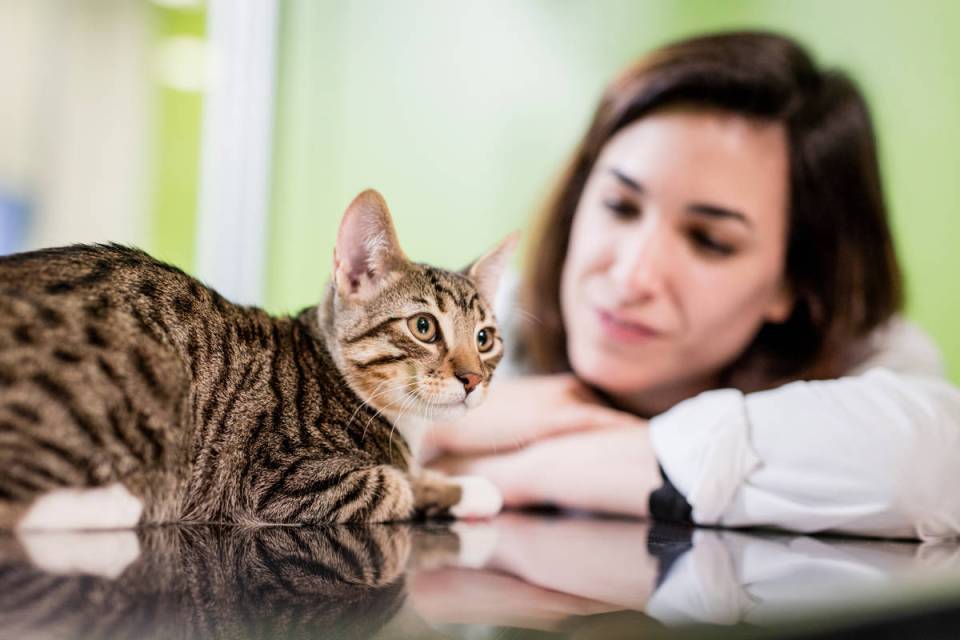
Leukaemia (Feline Leukaemia Virus Infection)

Introduction
Feline leukaemia virus (FeLV) is associated with the occurrence of tumours and anaemia in cats but also causes disease by suppressing the cat’s immune system. This results in the cat being susceptible to a variety of other problems, which may then be more serious as the cat is unable to fight disease efficiently. This is similar to the diseases seen in humans with the AIDS virus and in cats with Feline Immunodeficiency Virus (FIV). Despite the widespread use of vaccines, feline leukemia virus (FeLV) remains one of the most important causes of morbidity and mortality in cats. The virus is present worldwide and infects domestic cats and a few other Felidae.
Aetiology
FeLV is a retrovirus. There are 4 FeLV subgroups of clinical importance. Subgroup A viruses are found in all naturally infected cats. FeLV-A, the original form of the virus, is efficiently transmitted among cats. FeLV-A viruses tend to be less virulent than viruses of the other subgroups. Almost all naturally infected cats are originally infected by FeLV-A. Within the infected cat, in addition to the original FeLV-A mutated forms, FeLV-B, FeLV-C, or FeLV-T exist 1
Epidemiology
Young cats and particularly kittens, are especially susceptible to infection. As cats get older their susceptibility to infection declines. However, vaccination of older cats is recommended if they are considered ‘at risk’. The incidence of FeLV infection is directly related to the population density of cats. Infection rates are highest in catteries and households with multiple cats, especially when cats have access to the outdoors. Persistently viraemic cats shed large amounts of virus in the saliva, urine, tears and milk and so infection is transmitted by mutual grooming or sharing of food bowls. In addition, the infection can also be caused by biting or contact with urine and faeces containing the virus. The virus can also pass from a queen to her kittens either in the womb or after the kittens are born, via infected milkThe majority of cats become infected when the virus enters the body via the mouth or nose. The virus then multiplies at these sites before spreading to the rest of the body via the bloodstream and, in particular, to the bone marrow. Not all cats which are exposed to the virus become persistently infected. If the cat is able to eliminate the virus, this will occur during the initial stages (4 – 12 weeks) of infection. Once significant infection of the bone marrow is present, the cat remains infected for the rest of its life.
Clinical signs
Signs of infection can take months or years to develop and so infected cats can appear to be totally normal and healthy for quite some time.The forms of the disease include neoplastic forms and non-neoplastic forms with immunosuppressive, renal or reproductive involvement.The first signs of infection may be vague and non-specific because of the huge variety of problems that can occur with FeLV infection including:• Loss of appetite • Slow but progressive weight loss, followed by severe wasting late in the disease process • Poor coat condition • Enlarged lymph nodes • Persistent fever • Pale gums and other mucus membranes • Inflammation of the gums (gingivitis) and mouth (stomatitis) • Infections of the skin, urinary bladder, and upper respiratory tract • Persistent diarrhoea• Seizures, behaviour changes, and other neurological signs• Abortion of kittens or other reproductive failures
If tumours develop, the signs seen will depend on the site of the tumour and a variety of different sites may become infected like the chest, kidneys, gut and spinal cord.Lymphoma is the most common FeLV associated disease.
Diagnosis
When feline leukemia is suspected, a number of diagnostic procedures can be used in support of a diagnosis, including histopathologic examination of biopsies, bone marrow examinations and cytology of thoracic and abdominal fluids. However, the most practical way to diagnose FeLV infection is with the ELISA and IFA procedures referred to below. • The indirect fluorescence assay (IFA) of blood smears and the ELISA on serum are the procedures most commonly used for the detection of viral antigen. At least three blood smears are recommended for the IFA. A positive test indicates the presence of virus. • IFA tests must be sent to a diagnostic laboratory while ELISA tests can be performed in a veterinary clinic.
On post mortem examination, in cases of lymphoma, distinct masses may be found in the organs affected.
Control
Vaccination helps to stimulate a successful immune response to prevent cats from becoming persistently infected. Unfortunately, no vaccine is likely to be 100% effective in preventing infection. Vaccination is recommended in situations where cats have a risk of exposure to the virus. This includes cats that go outdoors and all those in contact with potentially infected individuals. Vaccines for FeLV must be given on an annual basis to ‘at risk’ cats. A number of vaccines are on the market either as single component vaccines or as vaccines that can be combined with other disease agents. For further information on vaccination, please contact your veterinary practitioner or visit www.vaccination.ie.
Any new cats entering a household or rescue centre should ideally be isolated for 4 weeks and tested for FeLV before being vaccinated and allowed to mix with other cats if the test is negative.All infected cats should be kept indoors, so as not to act as a source of infection for non-vaccinated cats. Currently there is no cure for FeLV infection, although anti- viral medications are now being used in an attempt to eliminate disease in some cases. Treatment should be aimed at maintaining quality of life and managing the effects of infection such as immunosuppression, anaemia and cancer.
For further information on disease and vaccination please click here.
1. Neil, J.C., Feline Leukemia and Sarcoma Viruses (2008) Encyclopedia of Virology (3)
